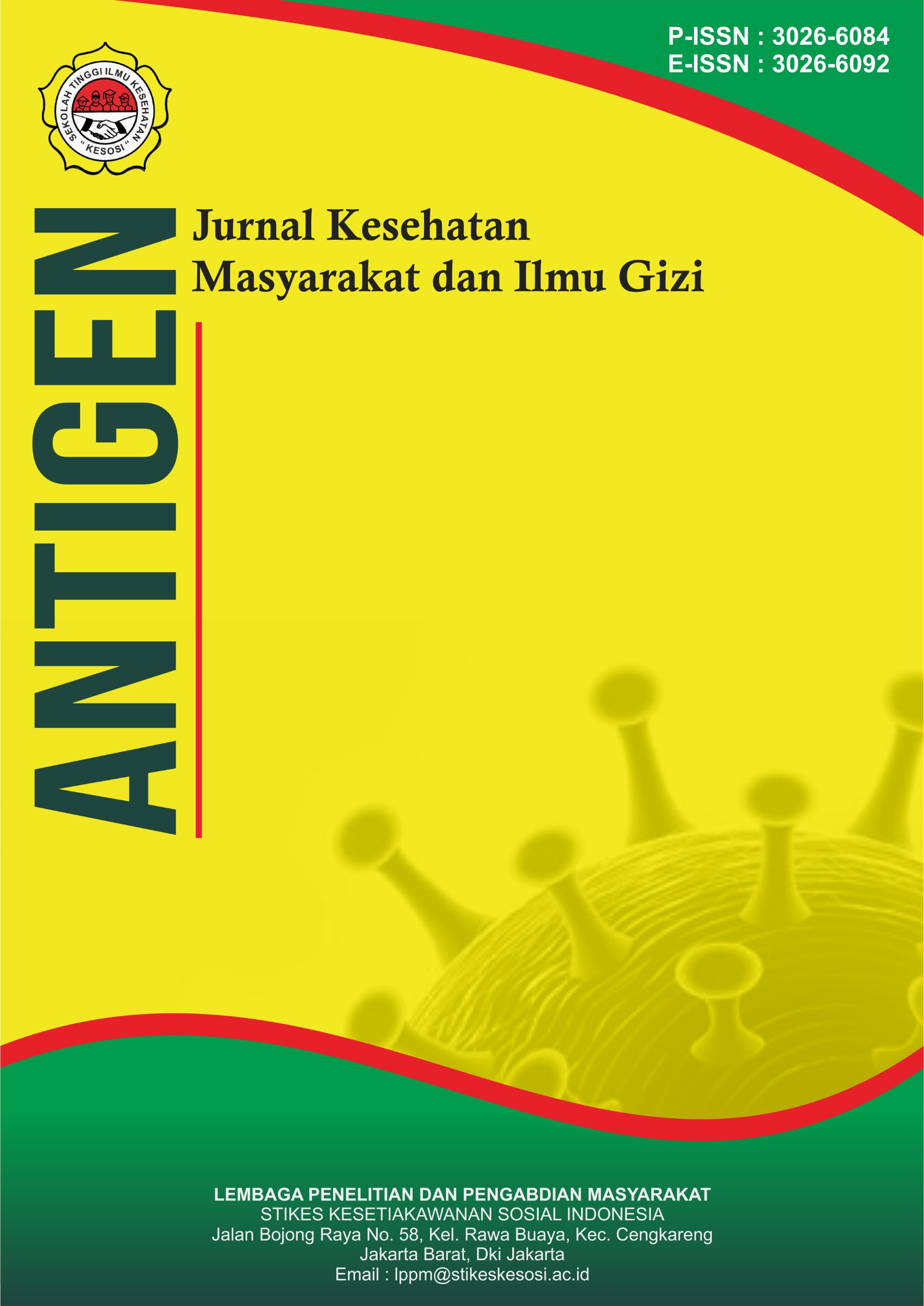Kepatuhan Diet dan Asupan Protein terhadap Kadar Glukosa Darah Puasa Pasien Diabetes Melitus Tipe 2 di RSUD dr. Iskak
DOI:
https://doi.org/10.57213/antigen.v3i3.811Keywords:
Adequate protein intake, Diet complieance, Fasting blood glucose levels, Type 2 diabetes mellitusAbstract
The management of blood glucose levels in individuals diagnosed with diabetes mellitus is a multifaceted process that involves the integration of pharmacological therapy and evidence-based nutritional interventions. Among these strategies, nutritional therapy plays a pivotal role in achieving optimal glycemic control and preventing diabetes-related complications. The success of nutritional therapy is closely tied to the individual’s adherence to prescribed dietary guidelines and the ability to meet adequate protein intake as recommended by healthcare providers. Protein is essential not only for maintaining muscle mass and supporting metabolic functions but also for its role in stabilizing blood glucose levels through slower glucose absorption and enhanced satiety. This study was conducted to investigate the relationship between dietary adherence and adequate protein intake with fasting blood glucose (FBG) levels among outpatients diagnosed with type 2 diabetes mellitus at RSUD dr. Iskak Tulungagung. A quantitative research method with a cross-sectional design was employed, involving 26 respondents selected using a non-probability sampling technique. Data collection utilized structured questionnaires to assess dietary compliance, interview forms to capture dietary behavior and protein intake patterns, and medical record documentation to obtain accurate FBG measurements. Statistical analyses included Pearson correlation tests for normally distributed data and Spearman rho tests for non-normally distributed data, ensuring appropriate analytical rigor. The results indicated a significant negative correlation between both dietary adherence and adequate protein intake with fasting blood glucose levels. This finding suggests that individuals who consistently follow dietary recommendations and consume sufficient protein tend to exhibit lower FBG values, indicating better glycemic control. Such results underscore the importance of not only emphasizing dietary compliance but also ensuring protein adequacy in daily nutritional plans for type 2 diabetes patients. These findings have practical implications for diabetes management programs, highlighting the necessity of sustained patient education, regular counseling, and individualized meal planning.
References
Anonim. (2023). Rencana kerja pemerintah daerah 2023.
Ciarambino, T., et al. (2022). Influence of gender in diabetes mellitus and its complication. International Journal of Molecular Sciences, 23(16), 1–13. https://doi.org/10.3390/ijms23168850
De Tata, V. (2014). Age-related impairment of pancreatic beta-cell function: Pathophysiological and cellular mechanisms. Frontiers in Endocrinology, 5(SEP), 1–8. https://doi.org/10.3389/fendo.2014.00138
Dewi, T., & Amir, A. (2018). Kepatuhan diet pasien DM berdasarkan tingkat. Media Gizi Pangan, 25(1), 55–63.
Dewi, T., Amir, A., & Sabir, M. (2018). Kepatuhan diet pasien DM berdasarkan tingkat pengetahuan dan dukungan keluarga. Media Gizi Pangan, 25(1), 55–63.
Dinas Kesehatan Tulungagung. (2020). Profil kesehatan tahun 2020. https://medium.com/@arifwicaksanaa/pengertian-use-case-a7e576e1b6bf
Ezekia, K. (2017). Metabolisme. In Textbook of hepatology: From basic science to clinical practice (3rd ed., pp. 129–249).
Gannon, M. C., et al. (2003). An increase in dietary protein improves the blood glucose response in persons with type 2 diabetes. American Journal of Clinical Nutrition, 78(4), 734–741. https://doi.org/10.1093/ajcn/78.4.734
International Diabetes Federation. (2019). IDF atlas. https://doi.org/10.1016/S0140-6736(55)92135-8
International Diabetes Federation. (2021). IDF diabetes atlas. https://doi.org/10.1016/j.diabres.2013.10.013
Lisnawati, N., et al. (2023). Hubungan indeks massa tubuh, persen lemak tubuh, dan aktivitas fisik dengan kadar gula darah remaja. Journal of Nutrition College, 12(2), 168–178. https://doi.org/10.14710/jnc.v12i2.36662
Magdalena, C. (2020). Hubungan penerapan 3J dan aktivitas fisik terhadap status kadar gula darah pada penderita diabetes mellitus tipe II. Jurnal Studi Kesehatan Masyarakat Universitas Islam Negeri Syarif Hidayatullah Jakarta, 1, 1–138.
Nalole, D., et al. (2021). Gambaran pengetahuan, status gizi, konsumsi zat gizi dan kepatuhan diet pada pasien diabetes mellitus. Gorontalo Journal of Nutrition Dietetic, 1(2), 75.
Novitasari, A. (2011). Perbedaan tingkat kekenyangan antara konsumsi tinggi protein dengan tinggi karbohidrat pada wanita usia 18–23 tahun.
Nursihhah, M., & Wijaya Septian, D. (2021). Hubungan kepatuhan diet terhadap pengendalian kadar gula darah pada pasien diabetes melitus tipe 2. Jurnal Medika Hutama, 2(DM), 9. http://jurnalmedikahutama.com/index.php/JMH/article/view/203
Riskesdas. (2018). Hasil riset kesehatan dasar tahun 2018. Buletin Penelitian Kesehatan, 53(9), 1689–1699.
Sahwa, A. D., & Supriyanti, E. (2023). Penerapan diet 3J untuk mengatasi ketidakstabilan kadar glukosa darah pada pasien DM tipe 2. Jurnal Manajemen Asuhan Keperawatan, 7(1), 22–26. https://doi.org/10.33655/mak.v7i1.156
Sinclair, J., et al. (2023). Effects of a home-based physical activity program on blood biomarkers and health-related quality of life indices in Saudi Arabian type 2 diabetes mellitus patients: A randomized controlled trial. Life, 13(6), 1–18. https://doi.org/10.3390/life13061413
Ubaidillah, Z., & Dipanusa, A. P. (2019). Faktor-faktor ketidakpatuhan diet pada klien diabetes mellitus. Journal of Borneo Holistic Health, 2(1), 17–29.
Umam, M. K., Imaningtias, W., & Listyaningrum, N. H. (2021). Gambaran kepatuhan diet pada anggota Prolanis selama. Jurnal Sehat Mandiri, 16(1), 29–35.
VinVa, F., Wilson, W., & Ilmiawan, M. I. (2021). Hubungan tingkat depresi terhadap kadar glukosa darah puasa pada penderita diabetes melitus tipe 2 di Poli Penyakit Dalam RSUD Sultan Syarif Mohamad Alkadrie Kota Pontianak. Jurnal Kedokteran dan Kesehatan, 17(1), 1–8. https://doi.org/10.24853/jkk.17.1.1-8
Wahjuni, S. (2013). Metabolisme biokimia. Journal of Chemical Information and Modeling.
Werdani, A. R., & Triyanti, T. (2014). Asupan karbohidrat sebagai faktor dominan yang berhubungan dengan kadar gula darah puasa. Kesmas: National Public Health Journal, 9(1), 71. https://doi.org/10.21109/kesmas.v9i1.459
World Health Organization. (2022). Diabetes. https://www.who.int/news-room/fact-sheets/detail/diabetes
Downloads
Published
Issue
Section
License
Copyright (c) 2025 Antigen : Jurnal Kesehatan Masyarakat dan Ilmu Gizi

This work is licensed under a Creative Commons Attribution-ShareAlike 4.0 International License.






